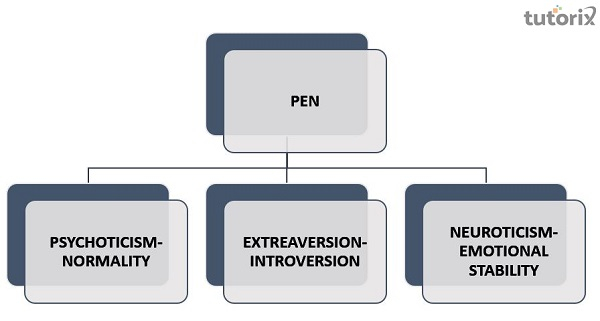Explain Eysenck’s trait-type theory.
Personality tests have a long history since way back 18th century. One such personality test laid first by Hans Jugen Eysenck describes that personality has a lot to do with biological factors such as genes and environmental cues. The Eysenck theory of personality describes the so-called “Eysenck Personality” (also known as Eysenck’s personality). This theory claims that all humans have a basic set of traits that define them as human beings, and each individual has an individual temperament or temperament type. Personality can be defined as how we behave in everyday life and respond to situations and events. In this way, persons with a particular temperament tend to behave differently from those with other temperament types. There are various theories about why some people do not fit in with others’ temperament types; this theory emphasizes genetic inheritance.
The National Institute for Health Science found out that only 40% of the population has no idea what being a “personality” means. According to Eysenck’s personality theory, you are more likely to be successful if you have more self-confidence than confidence in your ability to succeed.
Moreover, this instrument comprised 57 Likert-type questions that emphasize measuring two central dimensions of personality: extraversion and neuroticism. To learn more about these dimensions, let us dive further.
The PEN Model of Eysenck Instrument.
Earlier, as mentioned, there were only two dimensions of Eysenck’s personality theory which measure an individual’s extraversion and neuroticism traits. However, now Eysenck’s approach focuses on three dimensions named after PEN. Coming next are such dimensions.
Psychoticism-Normality − Psychoticism is a personality trait characterized by a lack of empathy, a poor ability to form attachments, and a lack of concern for others. People who are high in psychoticism are more likely to be aggressive, antisocial, and have substance abuse problems. In contrast, people who are low in psychoticism are more likely to be emotionally stable and empathetic and to have healthy relationships.
Extraversion-Introversion − In psychology, the terms “extraversion” and “introversion” describe two different personality types. Extraverted people are outgoing and friendly, and they tend to be energized by social interactions and quickly get bored when alone. Introverted people are more reserved and prefer solitary activities; they are often more thoughtful and reflective than extroverts. Both personality types have their strengths and weaknesses.
Neuroticism-Emotional Stability − Neuroticism is a personality trait characterized by anxiety, worry, and insecurity. People high in neuroticism tend to be more vibrant and reactive to stress, and they are also more likely to experience negative emotions like sadness, anger, and fear. Conversely, emotional stability is the ability to remain calm and level-headed during stress or adversity. It is a trait prized in many cultures and professions and can be learned and cultivated.

Biological Basis of Eysenck’s Personality Theory
The biological basis of personality is the collection of brain systems and mechanisms that underlie our differences in behavior and temperament. It includes everything from our genes to the structure of our brains to the chemicals that regulate our moods. Researchers are just beginning to understand the complex interplay of biology and the environment that shapes our personalities. Nevertheless, there is evidence that biology plays a significant role in who we are and how we behave. In this article, we will explore the evidence for the biological basis of personality and what it means for our understanding of ourselves.
- ARAS (Ascending Reticular Activation System) is responsible for bodily arousals such as mood, motivation and attention, and such arousal is highly seen in introverts than extroverts. Apart from ARAS, Cortical Excitation and Inhibition in the frontal cortex exhibits great response in introverts.
- Hypothalamus and limbic system, which is responsible for the emotional reaction, is hyperactive for people with neurotic traits and lower in emotionally stable people. Along with this, ANS (Automatic Nervous System) regulates flight or fight response in the body and is highly responsible for stress reactions in neurotic personalities.
The Four Basic Temperaments Measuring Eysenck’s Theory
The two factors of the five-factor model, extraversion-introversion and neuroticism-emotional stability, create four combinations related to the four basic temperaments recognized by Greeks −
- Melancholic (introverted + unstable) = sad, gloomy
- Choleric (extroverted + unstable) = hot-tempered, irritable
- Phlegmatic (introverted + stable) = sluggish, calm
- Sanguine (extroverted + stable) = cheerful, hopeful

Conclusion
We have discussed so far Eysenck’s theory. In this last part of the article, we conclude that the approach is based on the idea that there are two independent dimensions of personality. Furthermore, it has been influential in personality psychology and used to explain various phenomena, including individual differences in behavior and mental health




